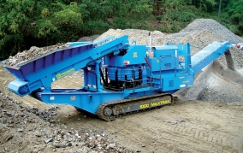Faster than Phelps
Tackling the ocean waves like Flipper is an exciting possibility with the Lunocet – a 15-inch high-performance monofin, capable of propelling its wearer at high speeds with dolphin-like leaps.
Mimicking the natural power and efficiency of the dolphin fluke stroke, the design is the result of seven-years of R&D from inventor Ted Ciamillo of Ciamillo Components. The carbon fibre hydrofoils and aluminium and titanium footplate were developed at the designer’s Virginia home, which even hosts a one million gallon testing lagoon.
“I can think of something in the morning and have it made on site this afternoon!” boasts Ted. This is made possible with a product development workflow which includes Solid Edge for design and engineering and seven CNC machines for prototyping. Having studied the natural movement of whales and dolphins, with the help of experts, the custom-fitted fins provide more power on the up-stroke than conventional mono-fins. And with attainable speeds of over eight miles an hour, eclipsing Michael Phelps in a straight race would be a breeze.
Keep an eye out for more from Ciamillo Components, as Ted gets ready for his next project: Crossing the Atlantic Ocean in a pedal powered submarine he’s designed.

The monofin mimics the natural power and efficiency of the dolphin fluke stroke
Seeing sounds

Based on its legendary reference speaker range, the 800 Series and with looks to die for, B&W’s Zeppelin is not your run of the mill ipod dock
An iPod dock that sounds as good as it looks is a rare thing in a world of cheap plastics and tinny-sounding speakers, yet the Bowers & Wilkins Zeppelin manages to combine hi-end audio with stunning looks.

Native used Rhinoceros 4.0 for the surface modelling and generating the externals, while the heart of the product was engineered by B&W using I-DEAS
Working with design specialist, Native, the elliptical shaped speaker system is set to be a design classic having already featured in design awards around the world. The team used Rhinoceros 4.0 for the surface modelling and generating the externals, while the heart of the product was engineered by B&W using I-DEAS.
Morten Warren, principal at Native describes how the Zeppelin shape was created to accommodate its function, “Its large bass unit sits in the centre, out from which the form tapers towards the ends, where the smaller mid-range and tweeter drive units are accommodated. Left and right channels are kept apart for the best possible stereo effect.
“The elliptical form has a visual purity and serves both to perform acoustically and to disguise its true physical volume, enabling it to appear to float gracefully wherever it is placed.”
Home on the range
Having worked on hundreds of products with BT during their 17 year relationship the team at TheAlloy is used to coming up with designs that maximise functionality without compromising form, and this has never been more true than with the new Home Hub from BT.

BT’s iconicHome Hub features a curved form, high-gloss black finish with blue LED lights and no external antennae
As wireless access becomes a necessity, even at home, products have to offer the right balance of aesthetics without limiting the improved technology contained within. Company chairman Gus Desbarats found that with the new Home Hub preserving functionality was a challenge.
“In terms of what the device was going to do, range was a big issue,” says Gus, “From a risk perspective the shape and the board configuration of the design can have a big impact on range, so if you don’t build that in early on in the process then there’s a big risk that you’re going to create something really cool, but compromises on performance.
“Our model is on a curve, it looks a bit like a radar dome, but it doesn’t help with performance, it’s purely visual. It’s also a bit of a risk as the board is flat and the danger is that if you don’t get it right (and if you’re not working early on in 3D to get it right) the problem ends up growing. Our project leader Nina Warburton and the team worked out how much of a curve we could get and what it would look like and we ended up with this drift that creates a really sexy external presentation.”

TheAlloy uses NX to help ensure designs are fit for function as they progress down the product development process
Gus believes that in the time-centred world of product design a design that offers functionality straight up to the point of manufacturing is the way to get ahead. “A lot of the conversation is that the product designers do the pretty bits and the engineers do the development bits but that’s very obsolete; other people are still doing the engineering, but we’re not shipping them surfaces, we’re shipping them solids.”
“The engineers can pick up our data and run with it: Our deliverable isn’t visual, it’s solid shells, but with no internal detailing. People doing the internals can just pick up what we send them and add ribs and bosses to that data. It’s really how designers and engineers should collaborate, but it’s surprising how rarely it happens.”
TheAlloy uses Siemens’ NX for the core solid modelling, and Cinema4D to produce renderings and animations.

Stephen Holmes looks at some of the most innovative new consumer products to hit the market











